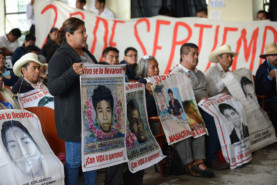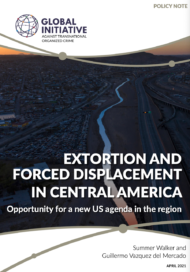Since Mexico launched its ‘war on drugs’ in 2006, nearly 39 000 unidentified bodies have been found in the country. Although the government has made efforts to identify them, relatives of missing people and other activists are fighting for access to better information.
The disappearance of 43 students in the state of Guerrero in 2014, and the impunity for the perpetrators, shone a spotlight on Mexico that drew attention in the international arena to the serious human rights abuses and crimes against humanity committed in the country. In 2017, the government sent a signal of hope to thousands of people with disappeared family members.
Then president Enrique Peña Nieto enacted a law that would lead to a centralized system to search for, locate and identify missing people – and to investigate and pursue the perpetrators. The new law provided for the development of a digital tool that would allow users to access, sort and extract information that would help families find their disappeared ones.
This opening up of access to data on disappearances emerged in the context of the country’s commitments to transparency and accountability, and in response to demands from a national citizen advisory board made up of families of the disappeared.
Expectations were incredibly high. A wide range of civil society organizations and search groups participated in the legislative roundtables that set out deadlines to comply with the commitments outlined in the law. The new digital tool was one of many that was to lead to a change in how disappearance-related human rights violations would be handled.
This centralized system promised to overcome the flaws of the previous digital system, which was riddled with technical problems, such as duplicate records and profiles of victims who had already been found. This new tool was to offer data that was standardized, validated, interconnected and public. It would allow people to locate disappeared individuals by searching through databases administered by public- and private-sector institutions, including jails, shelters and hospitals across the country.
However, it was not to be. Although the new tool, the Registro Nacional de Personas Desaparecidas y No Localizadas (national registry of disappeared and missing people), was launched in 2017, a number of obstacles stand in the way of consolidating the information housed in the system. For example, there is no open-format version of the database available to the public, which restricts the repurposing of that data and therefore limits the possibility of analyzing information.
Another problem is the omission of the names of missing people in the government’s public records. The national registry shares data in such a way that each individual’s identity is concealed. According to civil society organizations working in the fields of human rights and transparency, this is a major obstacle, as including the victims’ names would potentially allow family members to locate them and verify the information reported by state prosecutors to the centralized digital platform. Moreover, the new platform does not display additional information about the victims, such as recent photographs, videos or other media.
It is only possible to obtain justice, discover the truth and protect the public’s right to information with high-quality data that can help locate and identify those who are still missing. Lack of standardized criteria for gathering and organizing data on victims infringes on the right of thousands of families to learn the fate of loved ones who have tragically disappeared and stands in the way of justice, the act of remembrance and ensuring that history will not be repeated.
What is needed is access to public databases and standardized criteria for collecting and organizing information. This is key if Mexico wishes to fulfil its promise and allow for open information on enforced disappearances. The database’s limitations call into question the Mexican government’s real commitment to confronting and investigating this crime and punishing those responsible.
With the support of the Global Initiative Against Transnational Organized Crime, Mexican civil society organization Iniciativa Sinaloa has published a new report documenting the obstacles that stand in the way of consolidating data in the only centralized system tracking information on disappeared and missing people in Mexico.
Sin datos no hay verdad
Desde que en 2006 se inició la guerra contra el narcotráfico en México, en el país se han encontrado casi 39 000 cuerpos sin identificar. Aunque el gobierno ha impulsado iniciativas para encontrar a las personas desaparecidas, familiares y activistas luchan por el acceso a información de mayor calidad.
Una profunda crisis de impunidad por los 43 estudiantes desaparecidos en 2014 en el estado de Guerrero puso a México en el foco internacional como un país de graves violaciones de derechos humanos y crímenes de lesa humanidad. Pero en 2017, el gobierno mexicano envió una señal de esperanza a miles de familias con personas desaparecidas.
El entonces presidente Enrique Peña Nieto promulgó una ley que ordenó la creación de un sistema único de información para la búsqueda, localización e identificación de personas desaparecidas, y para la investigación y persecución de los perpetradores. La nueva ley consideró entre sus prioridades el desarrollo de una herramienta informática que permitiría el acceso, tratamiento y uso de información relevante para buscar a las personas que desaparecen en el país.
La apertura de datos sobre desapariciones en México se inserta en los compromisos que ha hecho el país en materia de transparencia, rendición de cuentas y derechos humanos, y ha sido una demanda del Consejo Nacional Ciudadano del Sistema Nacional de Búsqueda de Personas, integrado por familias de personas desaparecidas.
La expectativa era enorme. Un amplio grupo de organizaciones civiles y colectivos de búsquedas participaron en las mesas de discusión legislativas de donde surgió una normativa que estableció, al menos, 30 plazos específicos para cumplir con los nuevos compromisos. La herramienta digital se integraba a un conjunto de instrumentos rectores que abrirían el camino a un cambio de escenario para el ejercicio de los derechos humanos vinculados al delito de las desapariciones.
Este sistema único de información prometía superar las fallas del sistema digital anterior, que mostraba inconsistencias técnicas como la duplicidad de registros y perfiles de víctimas que ya habían aparecido. La nueva herramienta prometía un sistema de datos homologados, validados, interconectados y públicos, que contribuiría a la localización de personas desaparecidas mediante el rastreo de las bases de datos administradas por instituciones del sector público y privado, incluyendo cárceles, albergues y hospitales de las 32 entidades federativas del país.
Sin embargo, aunque la nueva herramienta, el Registro Nacional de Personas Desaparecidas y No Localizadas, fue lanzada en 2017, todavía existen muchos obstáculos para consolidar este sistema único de información. Por ejemplo, el formato actual del registro, en el cual la base de datos en formato abierto no es pública, impide reutilizar los datos y la información publicada, lo cual limita el análisis y el estudio del fenómeno de las desapariciones.
Otro problema es la omisión de los nombres propios de las personas desaparecidas en los registros públicos gubernamentales. El registro nacional se limita a difundir estadísticas en formatos que no muestran quién es quién. Desde el punto de vista de las organizaciones civiles especializadas en derechos humanos y transparencia, esto trasgrede el principio básico de identificación que merecen las familias de las víctimas para poder localizarlos y estar en posibilidades de confirmar la veracidad de la información que reportan las fiscalías estatales a la plataforma digital central. Además, la nueva plataforma no muestra información adicional sobre los desaparecidos, como fotografías recientes o videos u otros medios gráficos, que podrían ayudar a encontrarles.
Obtener justicia y conocer la verdad solo es posible con datos de calidad que permitan determinar la ubicación, localización e identificación de personas desaparecidas y no localizadas, y garantizar el derecho de la sociedad a conocer los hechos. La ausencia de criterios homologados para recabar y sistematizar información sobre las víctimas vulnera el derecho de miles de familias para conocer el destino de quienes no están, y garantizar la no repetición, la justicia y la memoria.
Es por ello necesario que el Gobierno de México se comprometa con la apertura de las versiones públicas de las bases de datos, y homologue los criterios para la recopilación y el tratamiento de información. La transparencia de las bases de datos es fundamental para que el Estado cumpla su promesa y posibilite el estudio del fenómeno de la desaparición forzada. El actual formato de las bases de datos pone en duda el compromiso del Gobierno mexicano de atender, investigar, dar a conocer los hechos y castigar a las personas responsables de este delito.
Con el apoyo de The Global Initiative Against Transnational Organized Crime, la organización civil mexicana Iniciativa Sinaloa ha realizado un estudio, «Sin datos no hay verdad: La lucha por el acceso a la información de desapariciones en México», que documenta los obstáculos para consolidar el sistema único de información sobre personas desaparecidas y no localizadas en México, las fosas comunes y clandestinas, los datos forenses y las detenciones, y su relación con el derecho de acceso a la información como herramienta fundamental para obtener justicia.
Autora
Norma Sánchez tiene 13 años de experiencia profesional en el desarrollo de proyectos sobre transparencia, rendición de cuentas, participación ciudadana y control de la corrupción. Cuenta con estudios en comunicación, periodismo y derecho y presidió el Sistema Estatal Anticorrupción de Sinaloa, México.



